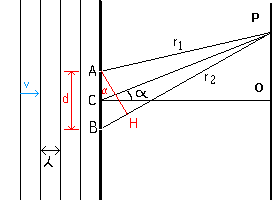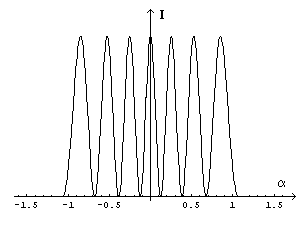Interference.
If a point P of a continuous and elastic medium is hit by two waves Ψ1
and Ψ2, emitted by two different sources O1 and O2,
from which it has distances, respectively, r1 and r2, it oscillates
as if it were hit by a single wave Ψ resulting from the sum of Ψ1 and
Ψ2.
-
If O1 and O2 oscillate in phase with equal amplitudes and equal angular frequencies,
using the prosthaphaeresis formulas, we obtain

The amplitude of Ψ is

This amplitude takes its maximum value 2A, when the absolute value of the cosine of in the equation (5.2) is 1,
ie when

The points P of the medium, for which the absolute value of the difference between the distances from
O1 and O2 is equal to an even number of half wavelengths, oscillate with the greatest amplitude.
Instead, the resulting amplitude vanishes, ie the point P does not oscillate, when the cosine is zero, ie when

The points P of the medium, for which the absolute value of the difference between the distances from
O1 and O2 is equal to an odd number of half wavelengths, does not oscillate.
In general, when there are two sources with these characteristics, the points of the medium oscillate
with different amplitudes, ranging from a maximum 2A to a minimum 0.
All the adjacent points which do not fluctuate form hyperboloidal surfaces called nodal surfaces.
The points that oscillate with greatest amplitude form hyperboloidal surfaces said antinodal surfaces.
If the two waves are one-dimensional, that is, if they propagate in a straight line medium, nodal and
antinodal surfaces become points called nodes and antinodes.
In this case, the midpoint between two sources is an antinode.
-
If instead the sources O1 and O2 are half cycle out of phase, that is, to give the idea,
they oscillate as the opposite dishes of a balance, the wave functions, with a suitable choice of the start time, are

Everything works as if the sources oscillate in phase but with the source O2 at a distance increased
by half a wavelength.
Therefore, the situation is reversed with respect to the previous case: now
the points P are nodes when the absolute value of the difference between their distances from
O1 and O2 is equal to an even number of half wavelengths.
Instead we find antinodes in points P such that the difference between their distances from
O1 and O2 is equal to an odd number of half wavelengths.
In this case, the midpoint between two sources is a node.
-
If the two sources oscillate with slightly different frequency, the phenomenon of beats occurs, that is
a periodic variation of the amplitude of the resultant wave.
Interference of light
If we project a beam of polarized monochromatic light on an opaque diaphragm, in which were made two thin
straight slits, parallel to each other and perpendicular to the plane of polarization of the light
and behind the diaphragm we put a white screen, at a distance large enough so we can consider this distance
infinite with respect to the distance d between the slits,
we observe on the screen not just two bright stripes corresponding to the slots, as one would expect based
on the principles of geometrical optics, but a series, which could be very large, of bright stripes
separated by dark stripes.
These strips are called interference fringes and they can be explained, only admitting that the light is a
wave.
In fact, on the basis of experiences of this kind, made by
T. Young,
the physicists of the nineteenth century, rejected the hypothesis, supported by Newton, that light is
made up of small discrete particles.

By accepting the Huygens' principle,
we interpret the slits A and B of the figure, reached at the same time
by the same wavefront, as sources of elementary cylindrical waves, which interfere in the point P of the screen OP,
having distances r1 from A and r2 from B.
If O is the point of the screen on the geometrical axis CO of the segment AB, and we denote by d
the length of the segment AB and by α the angle OCP and assume that the distance CO is infinite with
respect to d, we have

From the equation (5.2) we have

The maximum of the amplitude Amax is reached when α=0 and is 2A, so

The intensity, which is visually perceived as light intensity, from the equation (3.26), is proportional to
the square of the amplitude, thus

The intensity of the strip has its maximum when the absolute value of the cosine is 1, ie if

From the equation (5.6) we can see that our calculations make sense only if λ<d.
Moreover, if nmax is the maximum value of n,

then in the equation (5.6) n takes integer values from -nmax to nmax
so will see 2n-1 bright fringes separated by dark fringes. In the example shown in the graph below we
assume λ = 1/4 d.

If we represent by φ the phase shift between the two waves emitted by A and B in a point on the screen

the equation (5.5) can be rewritten as

The equation (5.9) expresses in general the intensity due to interference of waves of equal amplitude and
angular frequency and with a mutual phase shift φ.

![]()
![]()
![]()





